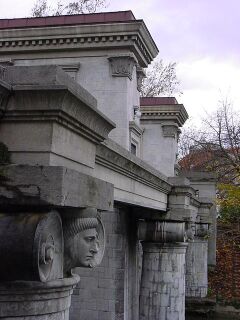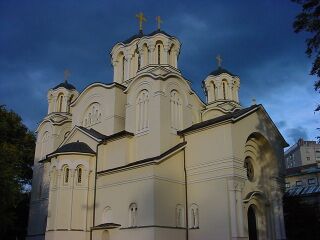
 Message Boards - Contact Us
Message Boards - Contact Us

|
Home - Search - Expat News -  Message Boards - Contact Us Message Boards - Contact Us |

|
Hidden Treasures
|
A Virtual Tour of Ljubljana, Part II 
Generally speaking, water-level control mechanisms are not renowned for their architectural refinement or sculptural beauty, but Plečnik's sluice gate (zapornica) is a typically elegant fusion of form and function. Situated just beyond St. Peter's Bridge in Poljane, the sluice gate is a striking three-towered structure adorned by massive stone vases, sphinx-heads and Ionic capitals, making it the architect's most outwardly "Hellenistic" work anywhere in town. Plečnik intended the sluice gate as a sort of valedictory arch, through which the river would depart from the city – of course Ljubljana was a much smaller place back in 1939.
Once again it was Plečnik's hand that transformed an ordinary municipal graveyard (founded in 1906, in what was then outer Bežigrad) into a solemn, imposing necropolis – a veritable city of the dead. A massive portal with a two-tiered colonnade frames the central oratory, and opens onto a tranquil, park-like setting dotted with funeral chapels that show the influence of ancient Greek, Gothic, Orthodox, even prehistoric religious art. The cemetery proper is a genuine sculpture garden, with prime examples of 19th century sentimentality and communist-era grandiosity, as well as a few Plečnik-designed tombstones. And then there's "New Žale", a weird conglomeration of concrete pyramids and gigantic crosses in an open field.

Between the two world wars Ljubljana was pretty much a one-architect town, and the work of Plečnik contemporaries like Vladimir Šubic and Ivan Vurnik is overshadowed by the master's opus even today. Besides the eye-catching Cooperative Bank building on Miklošičeva, Vurnik's most impressive work in Ljubljana is the Sokol gymnasium in the east-of-center Tabor area. Like the bank, this massive, block-length athletic center was designed in a unique style combining folk motifs and geometric abstraction; only here the color scheme is a bit of a letdown. The interior, with its high vaulted ceilings and arched windows, has a rather church-like ambience, and makes a peculiarly grand setting for gymnastics.

Surrounded by trees and isolated by busy roads, the Orthodox Church resides in an island-like world of its own, its "exotic" architecture only reinforcing this effect. Built between 1935 and 1940 by Serbian emigrants living (and evidently prospering) in Ljubljana, this graceful creme-colored structure, its five domed towers crowned by dazzling gilded crosses, is the emissary of a spiritual realm which begins for real some 300 miles further east. If you visit the church at the right time (daily except Mondays, 2 to 6 pm), you'll be able to view the spacious interior, with its brilliantly colorful murals.
Not so much "hidden" as impossible to take in at a single glance, this 30 km circuit of marked trails threading through Ljubljana's outskirts is both a reminder of history and a living recreational area. Numerous signposts and plaques reading "POT" (as in Pot spominov in tovarništva) mark the place where Ljubljana's World War II Italian occupiers erected a barbed wire barrier, intending to cut the city off from the outside world and choke its resistance movement. Now a very popular promenading and cycling path, the POT encompasses important sights like Žale Cemetery and Fužine Castle, the green slopes of Mostec and Golovec, suburban-industrial areas, and broad tracts of scenic countryside. |
|
![]()
Home | Search… | Contact Us
Copyright © 2006, Wagner & Associates and Ljubljana Life Magazine.
All rights reserved. This material may not be published, broadcast, rewritten, or redistributed.